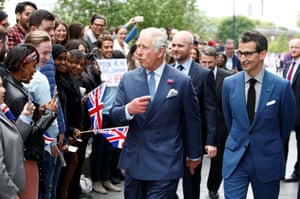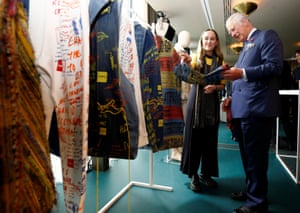When Prince Charles met British fashion designers, retailers and editors on Wednesday, he succeeded in steering conversation away from wedding dresses and on to clothes made from salvaged plastics and the prospects for reviving Scottish wool production.
The royal has long been a connoisseur and patron of traditional British menswear, but his interest in sustainability aligns him with the more hipster end of the fashion spectrum.
This visit was in support of the work of the Positive Fashion initiative, which promotes sustainability, best social and environmental practice, equality and local production.
Over sandwiches and mini Victoria sponge cakes at this spring’s most fashionable new London venue, the new White City outpost of the members’ club empire Soho House, the prince declined the modish cocktails made with Seedlip non-alcoholic “gin” and cucumber in favour of a cup of tea.

He admitted he was looking forward to the wedding on Saturday but preferred to discuss offering the use of his nettles (“I’ve got lots of those”) to Vin and Omi, a “responsible luxury” brand that produces organic fabric from plants from the Cotswolds and plastic bottles salvaged from cleanup projects.
The prince discussed how to bolster the British wool industry with Amy Powney, who has invested the prize money she was awarded last year by the prestigious British Fashion Council/Vogue Fashion Fund in making her east London label, Mother of Pearl, environmentally friendly and sustainable.
He also met Bethany Williams, a young designer using clothes to support women’s rehabilitation. For her latest collection, waste materials were woven into fabric by women at a drug rehab facility in Italy, before being constructed by prisoners at HMP Downview in Sutton in a scheme designed to teach women workplace skills.

The prince’s look was pure Savile Row – double-breasted suit tailored by the 112-year-old house Anderson & Sheppard, silk tie with a miniature elephant motif, striped Turnbull & Asser shirt – but the message was in tune with the mood of modernity and diversity being championed by a royal family who, from Saturday, will include a mixed-race woman with a successful career, a previous marriage and clear political views as a (de facto) princess.
Coming soon after the Queen’s surprise front row turn at London fashion week in February, it appears to signal a change in direction from the palace. Royal strategists have latched on to the fashion industry as a public platform because it is seen as modern and dynamic – and less likely to stir up any fractiousness between royals and the media.
In a pre-wedding week dominated by publicity around Thomas Markle Sr’s staged paparazzi photos, the White City event, in support of an industry that contributes £29.7bn in GDP to the UK economy and supports 850,000 jobs, hit a welcome positive note.